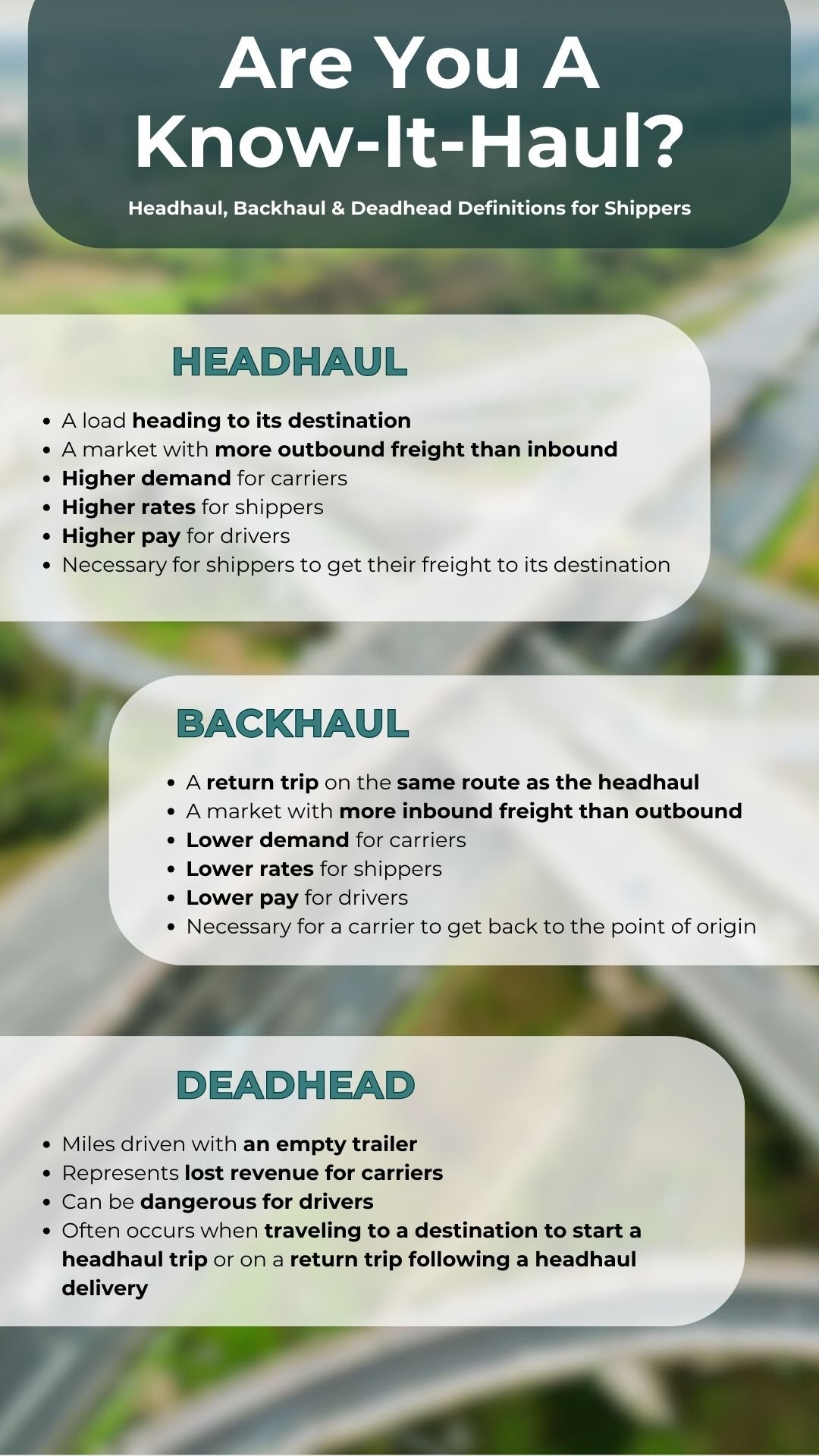Line hauls and tankers and BOLs, oh my! The transportation industry has a lot of lingo. As a shipper, if trucking isn’t your first language, you might struggle to keep up in conversations with your carrier.
To the uninitiated, “headhaul vs. backhaul” may sound more like a football play than anything to do with transportation.
But these phrases carry a lot of weight (See what we did there?) for transportation providers, truck drivers, and shippers like you. And if you opened the dictionary to “industry expert,” you’d find an Anderson Trucking Service (ATS) logo in place of a definition.
(Or at least you would if we wrote our own dictionary of trucking terms, which we totally have!)
With decades of experience providing transportation solutions and a sister company dedicated to shipping logistics, we definitely know our headhaul from our backhaul.
In this article, we’ll share our road-tested knowledge with you. We’ll define these terms and explain how they affect pricing for shippers. Along the way, we'll use some real-world examples to illustrate why these phrases are important to shippers.
At the end of this journey, you’ll have a thorough understanding of headhaul vs. backhaul markets and what they ultimately mean to shippers like you.
- Headhaul vs. Backhaul
- What does deadhead mean?
- Why does the transportation industry use terms like headhaul, backhaul and deadhead?
- Why is there a difference in pricing between headhauls and backhauls?
- How does a headhaul or backhaul market affect pricing for shippers?
Headhaul vs. Backhaul
Headhaul and backhaul are transportation industry terms used to describe loads and markets.
Traditionally, a headhaul was defined as a load headed to its destination, while a backhaul is a return trip back on the same route. Nice and easy, right?
Well, these days we have slightly more sophisticated definitions.
What is a Headhaul?
A headhaul market is one in which there is more outbound freight than inbound freight and pays a higher rate per mile (RPM).
Related: Freight Shipping Price: Rate Per Mile (PM) vs. Daily Rates
What is a Backhaul?
A backhaul market has more inbound freight and pays a lower RPM than it does outbound.
Why Does Headhaul vs. Backhaul Matter?
For truckers, the practical difference between a headhaul and a backhaul is simply “Which one pays more per mile?”
Whichever leg of the journey is more profitable for the driver in terms of RPM is the headhaul; the remaining leg is the backhaul.
Backhauls are less profitable for carriers because of the lighter demand for their services out of that market. We’ll dive deeper into that in a moment.
For shippers, these terms matter because the nature of each market (headhaul vs. backhaul) is a significant determining factor in your freight rate.
But before we get to the all-important money conversation, there’s also a third term we need to cover: Deadhead.
What Does Deadhead Mean?
Ah, deadhead. Headhaul and backhaul’s goth little sister. 😈
“Deadhead” or “deadheading” describes any time a truck is traveling with no load.
Ideally, a driver would always have a new load to pick up in the immediate vicinity of their headhaul delivery and again on the subsequent drop-off, but this isn’t always possible.
Deadheading commonly happens when trucks are traveling to a destination to start a headhaul trip. Deadheading is also common on return trips following headhaul deliveries.

Carriers avoid deadheading as if it were the plague, and for good reason. Deadheading represents a loss of revenue for carriers.
Think of it as a sort of purgatory between loads. With nothing to carry, the carrier is no longer providing a service for any customer, so the time spent traveling is essentially unpaid labor.
Deadheading can also be dangerous — an unloaded truck weighs about half as much as a loaded one. When trucks are not weighed down by a load, they can become hazardous in inclement weather.
Sorry, deadheading. It’s not you, it’s us: We’re down bad for safer, paid miles! 😍
Why Does The Transportation Industry Use Terms Like Headhaul, Backhaul and Deadhead?
These terms provide a simple, shared language between shippers, carriers, and drivers.
This shorthand quickly communicates information about how a given set of markets fit into the larger picture of lanes, loads, and operating costs.
Here’s a breakdown of all three terms at a glance:
Why Is There A Difference In Pricing Between Headhauls and Backhauls?
It all comes down to supply and demand. The volume of freight vs. the capacity of the market determines the cost of operating in a given area.
Let’s use the cities of Chicago and Miami as an example.
Thanks to its bustling manufacturing industry, Chicago often has more freight to transport than there are drivers to move it. The market must offer a higher RPM to attract more drivers.
That makes Chicago a headhaul market. If a driver is paid to take freight from Chicago to Miami, that lane would be a headhaul.
Once our hypothetical driver gets to Miami, their RPM leaving that market will be lower. Thus, Miami is a backhaul market.
But why is the RPM lower in Miami than it is in Chicago?
With little manufacturing in Miami, there’s a high demand for freight coming in, but not much freight going out. Carriers have to leave Miami, and with so few options to do so, they’d rather accept a lower RPM than travel with no cargo.

It’s important to note that the above example represents a snapshot in time, not an unchanging truth.
While it’s true that some markets are always going to be headhauls (like Chicago,) lanes can and do temporarily switch between headhaul and backhaul. This is due to external factors like seasonality, freight mix, and the ebb and flow of market trends.
There’s even a period during which some could argue Miami gets closer to a headhaul market — produce season.
It just goes to show that the transportation industry is fluid. That’s why it’s in the best interest of shippers, carriers, and drivers alike to develop a keen understanding of the markets over time.
Related: Load-to-Truck Ratios: An Overview of How They Impact Your Freight Rates
How Does A Headhaul Or Backhaul Market Affect Pricing For Shippers?
It’s good practice for shippers to know whether a lane is a headhaul or backhaul so they can better understand their network and costs.
By now, you know to expect a headhaul to be more expensive than a backhaul, so let’s explore three ways you, as a shipper, can minimize the impact of that price disparity on your bottom line:
1) Know Your Markets
Whether they’re shipping to a mere handful of markets or a baker’s dozen, shippers benefit from developing thorough market knowledge.
There are many contributing factors that impact freight rates for headhaul and backhaul markets, including:
- Freight volume
- Freight type
- Carrier capacity
- General economic conditions & national market
- Lane economics (RPM vs. fuel costs)
- Truck & trailer type required
- Special load, handling, and/or warehousing requirements
- Spot, contract, or special project pricing
As a shipper, strive to keep track of these price-informing elements for each of your markets. This data can help you create a realistic shipping budget and drive your carrier strategy.
2) Work With Your Carriers to Create Efficiencies
Synergy is your friend when it comes to your carrier relationships. Working with your carrier to streamline your lanes can create efficiencies that will save you money.
If you work together to ensure drivers have an immediate backhaul following a headhaul, your carrier may be able to cut you a better rate. Carriers want to have loaded trucks moving more often than not, so if your shipments offer a high loaded percentage, they may be able to shrink your rate.
Try to understand as much as you can about not only your own costs, but your carrier’s operating costs as they relate to your specific shipments and lanes.
This won’t only help you recognize potential savings; you’ll become a better customer of your carrier and make you, your provider, and its drivers happier in the process.

3) Communicate Consistently
So sayeth the immortal lyrics of “Funkytown:” Talk about it, talk about it, talk about it, talk about it.
It may seem obvious, but good communication practices are critical to building the business relationships that drive better service and pricing.
Clear, regular communication between shippers and carriers is vital to identifying strategies for better lane planning and cost reductions.
To wit: Keep your provider in the loop regarding any factors that could impact pricing. These could be changes to freight volume, planned expansions into new markets, or loss of an existing market, etc. This will prevent surprises and empower better planning and service on the carrier’s end.
That kind of consideration for your provider’s operations (Aww, aren’t you thoughtful? 💞) can pay dividends in the form of pricing efficiencies.
It’s said that a rising tide lifts all boats. When carriers and shippers understand what the other is doing, what they can offer, and how they can use it to their advantage, that rising tide lifts all trucks, too. (I never said it was a perfect metaphor.)
Your Next Step Toward an Efficient Supply Chain
Now that you know the definitions of headhaul and backhaul (and that unwelcome ride-along, deadhead,) you can better understand the economics of a lane at a glance.
This can inform conversations and planning with your providers, helping drive efficiencies and potential cost-savings.
If you’re curious about how transportation companies like ATS determine the route your shipment takes from market to market, we’ve got an article for that! Learn how a trucking company determines your freight’s route.
At ATS, we’re happy to help you manage your supply chain questions, even if we’re not in your carrier network! Don’t hesitate to reach out to our team for further information about the specifics of your lanes, pricing, and more.





